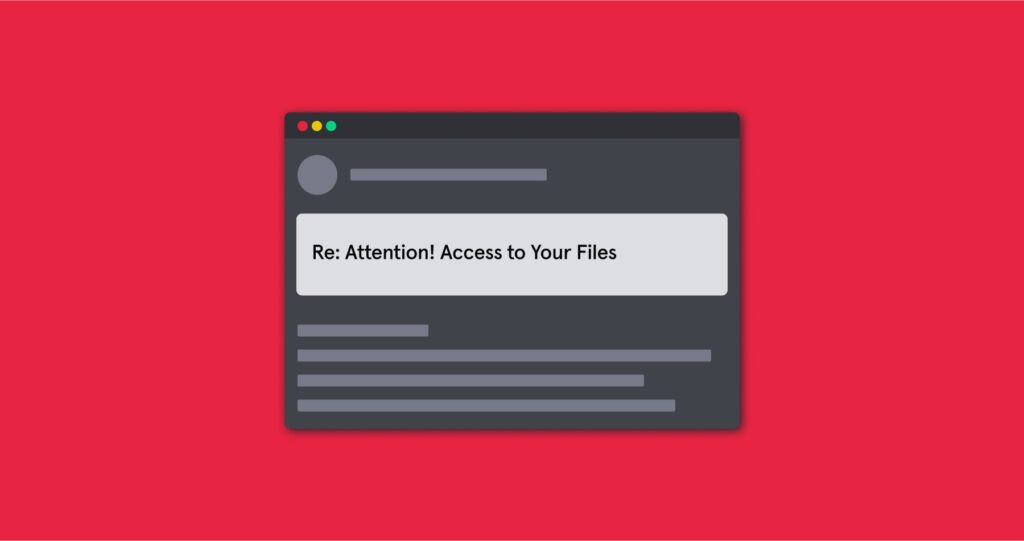Before we dig into how Tessian can help prevent ransomware attacks, let’s first define what exactly ransomware is, and explain the scope of the problem.
What is ransomware?
Ransomware is a type of malware that threatens to publish a victim’s data (or perpetually block access to it) unless a ransom is paid.
Most ransomware and their variants have multiple attack vectors and often the ransomware (and other malware) is distributed using email spam campaigns, or through targeted attacks. For example, a phishing email may contain a link to a website hosting a malicious download or an attachment. If the email recipient falls for the phish, then the ransomware is downloaded and executed on their computer.
After a successful ransomware attack, security professionals and business executives are faced with conflicting options. Paying the ransom encourages future attacks. Yet the recovery could be far more costly than the original demand.
You can learn more about what ransomware is in this article: What is Ransomware? How is it Delivered?
How big of a problem is ransomware?
In a word: BIG. You can’t go a day without seeing a headline related to ransomware.
That’s because ransomware continues to evolve and can halt businesses, slow down productivity, and destroy an organization’s reputation overnight. These types of attacks are often subtle and highly effective, using social engineering attacks until users are tricked into clicking a phishing link or opening a file attachment.
Worse still, the majority of organizations are unable to prevent ransomware early in the email cyberattack kill chain and remain vulnerable against these highly sophisticated attacks.
Why? Because legacy solutions don’t effectively detect and prevent this type of threat and there can be multiple threat vectors attacking a single organization in several different ways. The chances of success (for the hacker) are high.
Want to see examples of email cyber attack kills chains for ransomware? Download our Solution Brief.
To paint a more clear picture of the impact, check out these stats:
- A new organization will fall victim to ransomware every 14 seconds in 2019, and every 11 seconds by 2021
- Ransomware damage costs will rise to $20 billion by 2021 and a business will fall victim to a ransomware attack every 11 seconds at that time
- The ransomware attack on Universal Health Services (UHS) cost them $67 million. (This is mostly due to the operational problems post attack — diverting patients to competing facilities for urgent care.)
If you’re looking for real-world examples of ransomware attacks, we share seven here: 7 (Recent) Examples of Ransomware Attacks.
How does Tessian help prevent ransomware?
Unlike legacy solutions, Tessian Defender is powered by machine learning and automatically detects and prevents advanced forms of phishing attacks – including those that deliver ransomware – by default.
Importantly, this happens early in the kill chain to prevent credential theft, lateral movement, exfiltration, and more.
In addition to detecting and preventing threats, Tessian also provides in-the-moment training to help employees identify malicious emails, and nudge them towards safer behavior.
Solution highlights include:
Threat detection
Tessian’s algorithms continuously analyze and learn from email communications across its global network to build profiles and models of companies and their employees, to understand what their normal email communication looks like.
This helps catch even the most advanced forms of phishing attacks that could lead to ransomware.
Learn more about Tessian’s technology here.
Rapid remediation
Real-time alerts of inbound email threats to dedicated mailboxes. Explainable machine learning helps SOC teams understand quickly why an email has been classified as malicious.
By aggregating similar events and grouping emails from the same compromised account, Tessian allows administrators to clawback/delete multiple events with a single click.
Learn more about Tessian’s robust remediation tools here.
In-the-moment training
Non-disruptive in-the-moment training and awareness is provided to employees through contextualized, easy to understand warning messages that continually drive them towards secure behavior.
Learn more about Tessian in the moment warnings here.
Flexible deployment and seamless integrations
Defender deploys in minutes and automatically prevents data breaches through email within 24 hours of deployment, across all devices, desktop and mobile.
Learn more about Tessian’s integrations, compatibility, and partnerships here and see what customers have to say about deployment here.












